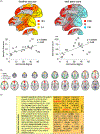Meta-connectomics: human brain network and connectivity meta-analyses
- PMID: 26809184
- PMCID: PMC8683119
- DOI: 10.1017/S0033291715002895
Meta-connectomics: human brain network and connectivity meta-analyses
Abstract
Abnormal brain connectivity or network dysfunction has been suggested as a paradigm to understand several psychiatric disorders. We here review the use of novel meta-analytic approaches in neuroscience that go beyond a summary description of existing results by applying network analysis methods to previously published studies and/or publicly accessible databases. We define this strategy of combining connectivity with other brain characteristics as 'meta-connectomics'. For example, we show how network analysis of task-based neuroimaging studies has been used to infer functional co-activation from primary data on regional activations. This approach has been able to relate cognition to functional network topology, demonstrating that the brain is composed of cognitively specialized functional subnetworks or modules, linked by a rich club of cognitively generalized regions that mediate many inter-modular connections. Another major application of meta-connectomics has been efforts to link meta-analytic maps of disorder-related abnormalities or MRI 'lesions' to the complex topology of the normative connectome. This work has highlighted the general importance of network hubs as hotspots for concentration of cortical grey-matter deficits in schizophrenia, Alzheimer's disease and other disorders. Finally, we show how by incorporating cellular and transcriptional data on individual nodes with network models of the connectome, studies have begun to elucidate the microscopic mechanisms underpinning the macroscopic organization of whole-brain networks. We argue that meta-connectomics is an exciting field, providing robust and integrative insights into brain organization that will likely play an important future role in consolidating network models of psychiatric disorders.
Keywords: Connectome; cytoarchitectonics; gene expression; graph theory; neuroimaging.
Conflict of interest statement
Declaration of Interest
ETB is employed half-time by the University of Cambridge and half-time by GlaxoSmithKline (GSK); he holds stock in GSK.
Figures




References
-
- Bargmann CI, Marder E (2013). From the connectome to brain function. Nature Methods 10, 483–490. - PubMed
-
- Bullmore E, Sporns O (2009). Complex brain networks: graph theoretical analysis of structural and functional systems. Nature Reviews Neuroscience 10, 186–198. - PubMed
-
- Bullmore ET, Frangou S, Murray RM (1997). The dysplastic net hypothesis: an integration of developmental and dysconnectivity theories of schizophrenia. Schizophrenia Research 28, 143–156. - PubMed
Publication types
MeSH terms
Grants and funding
LinkOut - more resources
Full Text Sources
Other Literature Sources
Medical

